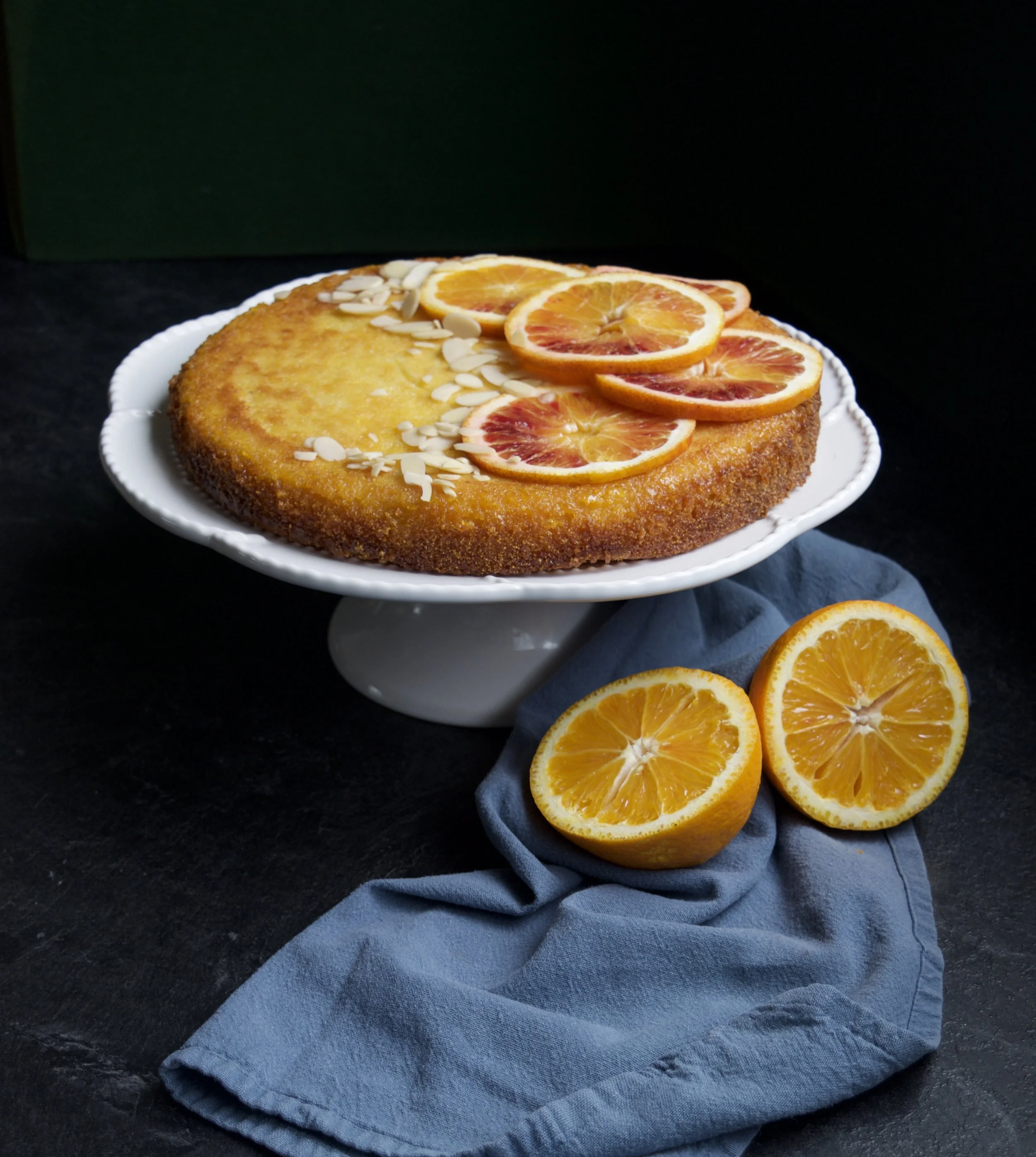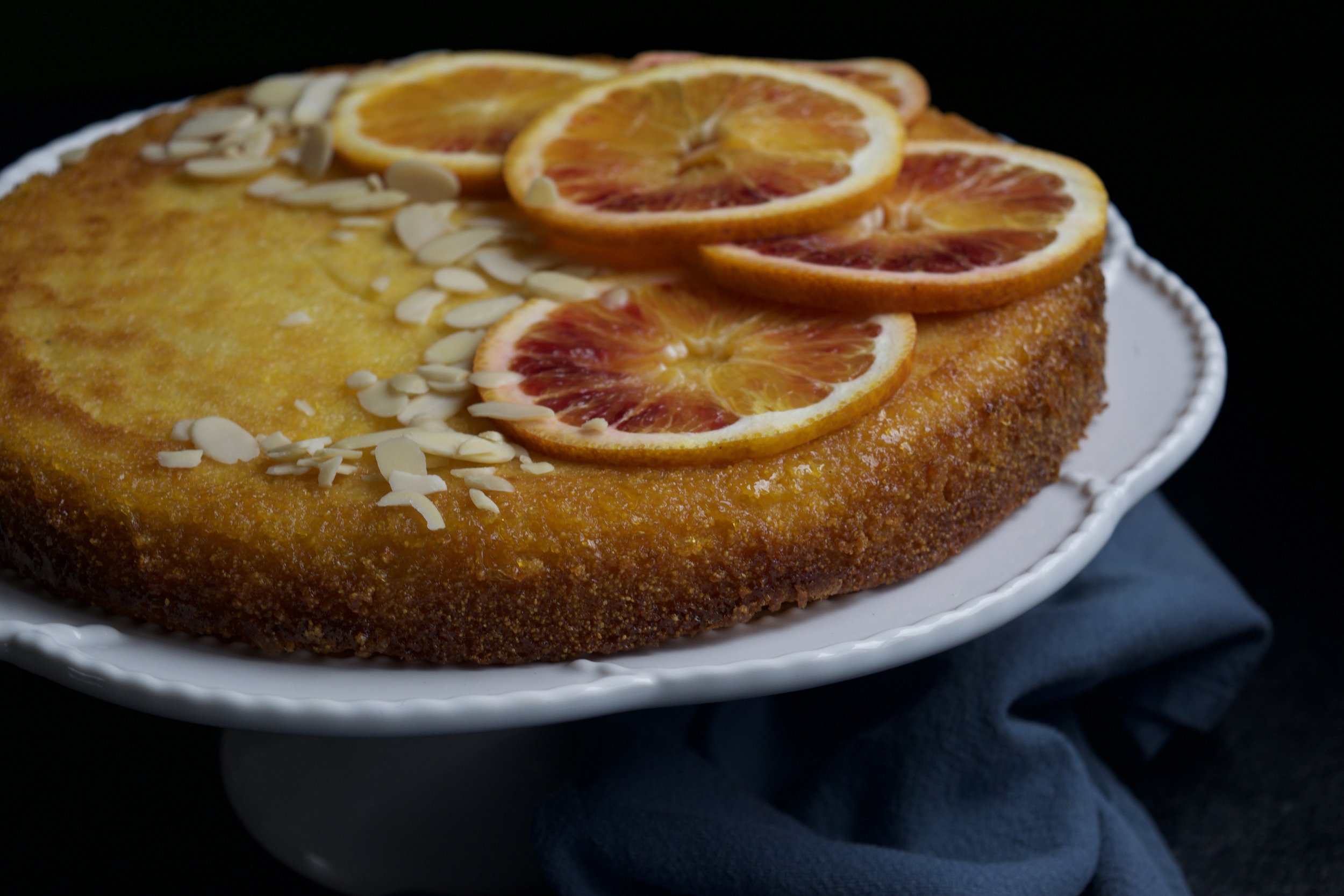Almond-Orange Syrup Cake
In high school I spent every Saturday and Sunday morning working as a server during the weekend brunch rush at my Aunt's family's Middle Eastern cafe. Although I love Middle Eastern dishes like shawarma, hummus, vine leaves, and falafel, I also have a soft spot for their sweets. One of the chefs at the cafe would make the most amazing semolina cake that was drenched in a rosewater syrup. This was a Syrian recipe, but this type of cake is seen in many Middle Eastern cuisines. Semolina is a part of the the wheat kernal that is removed during flour milling, and is then ground into a course flour. This kind of flour can be made from other grains, such as rice and corn as well. Semolina flour is used to make pasta and couscous, and also in baked goods like cornbread. The semolina gave this cake a unique texture that held moisture really well, and it was unlike any dessert I'd had before.
This cake reminds me of those Middle Eastern treats. It is made using almond flour and finely ground corn semolina (otherwise known as cornmeal), making it gluten-free. Instead of drizzling a syrup over the cooked cake, I spread the warm syrup into the bottom of the pan and pour the cake batter on top. This results in an incredibly moist cake, but also gives it an amazing caramelized crust. If you are like me and live for those crispy, caramel-y bits then you'll appreciate this cake. The cornmeal and almond flour work beautifully together to avoid the crumbly, grainy texture so many gluten-free baked goods suffer from and create a light and delicate crumb.
I like to use blood oranges for this cake, which are only in season for a few months between January and May. These oranges have a beautiful crimson colour and a more complex taste than regular oranges, but they can be hard to find, so you can certainly substitute regular navel oranges. I've made this cake the last few years for Easter, and its been a big hit with my Middle Eastern relatives.
To me this cake is a great way to welcome in Spring and warmer weather. it's bright, airy, and a refreshing burst of colour amidst all the Easter chocolate.
The whole thing can be made in one bowl, and there's no cake layering or icing required. That being said, this cake can still be a stunning addition to your table. I chose to top it with some thinly sliced blood oranges I had left over from making the cake, but some flowers arranged on top would also look lovely. Try some small white flowers like baby's breath, hydrangeas, or even daisies.
Happy Spring!
Almond-Orange Cake
serves 8-10
1 cup of 2% milk
1/2 cup of butter, unsalted
1 cup of cornmeal or polenta
1 cup of sugar
4 large eggs
1 cup of almond flour
2 tsp baking powder
1/4 tsp salt
2 tsp orange zest (about 2 oranges)
2 tbsp orange juice (about 1/2 a large orange)
For the Syrup
1/2 cup granulated sugar
1/4 cup orange juice
1. Grease a 9-inch springform pan and line the bottom with parchment paper. preheat the oven to 350. Place the milk and butter in a medium-sized pot over medium-high heat, and heat until the butter has melted and the milk has just come to a boil. ** Make sure to bring the milk up to a full boil, otherwise you may have trouble thickening the cornmeal in the next step.
2. Place the cornmeal in a large bowl and pour the hot milk and butter over it slowly, whisking constantly. The cornmeal should thicken up to a porridge consistency. Add in the sugar and whisk until combined, then add in the eggs, one at a time, whisking after each addition.
3. Whisk together the almond flour, baking powder, and salt, and add it to the wet mixture. Stir in the orange zest and orange juice.
4. To make the syrup, place the sugar and orange juice in a small pot over medium heat, and cook, stirring frequently, until all the sugar has dissolved (about 5 minutes).
5. Place the greased springform pan onto a baking sheet, and working quickly, pour the hot syrup into the bottom of the pan, making sure it covers the bottom pan evenly. Pour the cake batter on top of the syrup, and cook on the middle rack of the preheated oven for 45-50 minutes.
6. Allow the cake to cool fully in the pan, then release the cake from the springform pan and flip it onto a serving plate so that the bottom is facing upwards.





